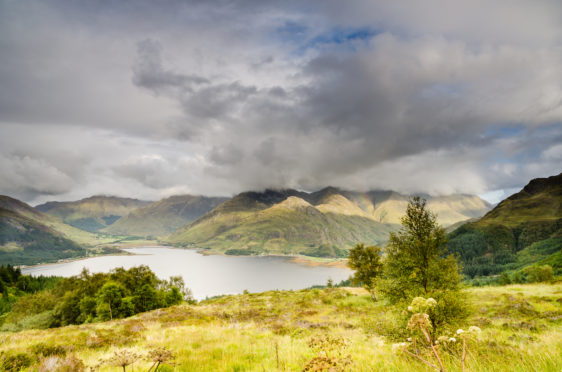
The classic view of The Five Sisters of Kintail – of which Sgurr Fhuaran is the highest – is from a layby on the Glenelg road as it climbs steeply through Ratagan Forest.
They form a vast mountain wall, the five pointed peaks surging vertiginously from the waters of Loch Duich. It’s no wonder the original Gaelic name for the range was Bheinn Mhor – “big mountain”.
The sheer scale of the mountains in this part of Glen Shiel is something to behold. I can’t think of anywhere else in Scotland where hills of such bulk rise so steeply so close to the roadside. The effect, especially on a gloomy day, can be quite intimidating.
The Five Sisters and much of the surrounding area, including the spectacular Falls of Glomach, is owned by the National Trust for Scotland, and were purchased for the nation in 1944.
From the east, the Five Sisters are Sgurr na Ciste Duibhe (Munro), Sgurr na Carnach (“promoted” to Munro status in 1997), Sgurr Fhuaran (Munro), Sgurr nan Saighead and Sgurr na Moraich. The traverse – usually completed from east to west – is one of the Scottish mountaineering classics and the route I recommend.
Most walkers will want to climb the Munros, and it’s possible to descend the north-west ridge from the summit. It’s a long, punishing descent however and, if the River Shiel is impassable, it’s a rough, pathless walk to Shiel Bridge.
Far better is to carry on over the fine peak of Sgurr nan Saighead – perhaps the most exciting hill in the group. The descent to Ault a’ Chruinn can be made from the north-west ridge of Beinn Bhuidhe but purists will want to contine to the fifth Sister, Sgurr na Moraich.
If possible, leave a vehicle at Ault a’ Chruinn as it’s eight miles by road from the start point.
Peak inspired by battling Spaniards
The first peak traversed en route to the Five Sisters is called Sgurr na Spainteach, or “peak of the Spaniards”.
It’s named in honour of Spanish troops who fought alongside Jacobites against the British Army at the Battle of Glen Sheil – the culmination, and only battle, of the 1719 Uprising.
The battle, on June 10, saw 1,150 Jacobites and perhaps 300 Spanish soldiers defeated by a contingent of British Government Red Coats – mostly Scottish troops – led by General Joseph Wightman. It’s the last engagement between foreign and British troops on UK soil.
The Spaniards were an advance party for an invasion fleet of 5,000 soldiers from Spain. But bad weather wrecked the ships.
Following the defeat, the Spanish troops fled over the mountain now named after them.
The outlaw Rob Roy Macgregor also fought for the Jacobite cause at the battle.
Guide
Sgurr Fhuaran (Five Sisters)
Pronunciation: Sgoor Oor-an; Meaning: Possibly peak of the spring, or peak of the wolf
Height: 1067m (3501ft);
Rank: 70
OS Landranger Map 33
Summit grid ref: NG978167 (cairn)
Nearest town: Shiel Bridge, is 5km (3 miles) north-west of the summit. Facilities are limited but there is a campsite, and hotels, inns and places to eat in the surrounding area. There’s a Youth Hostel nearby at Ratagan.
The route
Start grid ref: NH005136
Distance: 12km (7.5 miles)
Ascent: 1600m (5249ft)
Time: 9hrs
There’sa parking area on the north side of the A87 down Glen Sheil. From there, climb alongside an area of forestry. The route lies west and is obvious on a clear day – a twisting ridge.
Traverse Sgurr nan Spainteach before the Munro of Sgurr na Ciste Dubh, 1027m (3369ft).
The second Munro, the 1002m (3287ft) Sgurr na Carnach, is reached by descending west then north-west to the Bealach na Craoibhe, from where the summit is a short ascent north.
Descend north to the Bealach na Carnach then climb a steeply zig-zagging path to the summit of Sgurr Fhuaran. Continue over Sgurr nan Saighead.
The narrow ridge continues to Beinn Bhuidhe. Descend first north-east then climb north-west to Sgurr a’ Moraich.
From the summit, head along the north-west ridge for several hundred metres from where a steep descent can be made to a path above the Allt a’ Chruinn, which can then be followed out to Ault a’ Chruinn.


Enjoy the convenience of having The Sunday Post delivered as a digital ePaper straight to your smartphone, tablet or computer.
Subscribe for only £5.49 a month and enjoy all the benefits of the printed paper as a digital replica.
Subscribe